Now I get to turn my thoughts back to our intrepid traveller Celia Fiennes and the gardens she visited but felt after all that work I deserved at least a weekend off so on the first day, I slept. On the second day I decided to go see some London landmarks that Celia included in her journal. Celia went to live with relatives in London after her mother died in 1691 but obviously visited the city before then because she witnessed the coronations of James II (1685), William and Mary (1689), and Anne (1702) as well as the funeral processions of both Mary (1695) and William (1702). She describes the processions, the pomp, and the finery in quite a lot of detail which makes me eager to witness Queen Elizabeth II's Diamond Jubilee celebrations. Perhaps 300 years from now someone will stumble on my diary and read about it. Must take good note of things!
Well, to get my head properly in place, I went to London on a fine, sunny day and had this odd thought: I think I'll climb The Monument. I entreat you now, if ever I have the odd thought of climbing 311 stairs inside a 15-foot wide, 202-foot high free-standing fluted Doric column just for the fun of it, please slap me.
Of The Monument Celia says: There is alsoe at ye Bridge a Great Monument of stone worke...this is of a Great height 300 stepps up and on ye top gives ye view of ye whole town. This was sett up in memory of Gods putting a Check to ye Rageing flame wch by ye plotts and Contrivance of ye papists was Lighted. There is a Large Inscription on it all round mentioning it, and alsoe of ye popish plott and ye gun powdr treason and all by ye papists.
The Monument, or The Monument to the Great Fire of London, commemorates the Great Fire of 1666 which wiped out most of the Medieval City of London within the ancient Roman city walls.
 |
| A Plan of the City and Liberties of London, Shewing the Extent of the Dreadful Conflagration in the Year 1666 by John Noorthouck 1772 (mapco.net) |
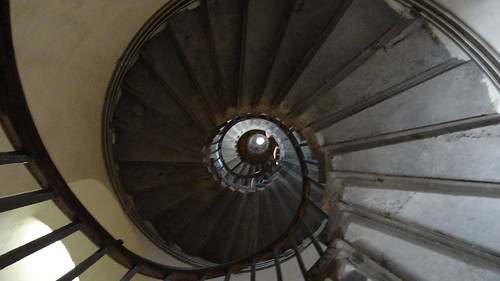 |
| The start of my ascent |
As I climbed, huffing and puffing, I kept trying to imagine what it would have been like to attempt this monumental feat (pun absolutely intended) in a long skirt, petticoat, bodice, and corset (don't even get me started on the shoes), with no light but the knifes of sunlight through the slitted windows in the building (the steps are black, by the way, and even with modern lighting it's dark and dangerous up there!). The mind boggles. Still, I did it, and when I reached the top I was entertained to see climbers of yore had left their mark.
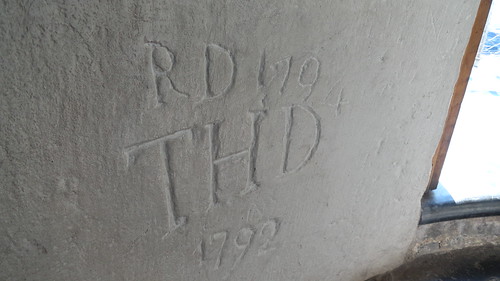 |
| Antique graffiti (the top says, "RD 1794", the bottom, "THD 1792") |
Celia was wrong, though, it's not 300 steps to the viewing platform 160 feet up, it's 311 and I climbed each and every one of them. She doesn't specifically state that she climbed to the top (she could have heard it from someone else) but I bet she did so we'll give her the benefit of the doubt. The view is still spectacular, but other than a few remaining landmarks, I don't think Celia would recognize the city.
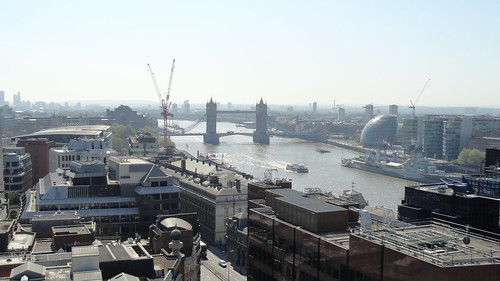 |
| The Tower of London was there in Celia's time but the iconic Tower Bridge wasn't begun until nearly a century later, in 1886. |
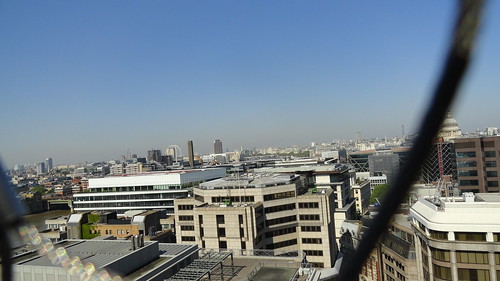 |
| The dome of St. Paul's (just visible behind the protective wire cage) wasn't complete until 1711 so depending on when Celia climbed these steps, she may or may not have seen the dome. |
I didn't scratch my name in the wall, but I did receive a nice commemorative certificate when I successfully made it back down (at which point my entire lower half turned to jelly). I spent about half an hour recovering on a bench conveniently located midway between The Monument and the spot at which the Great Fire started, at a baker's shop in Pudding Lane. If the management had any marketing sense, there would be a bakery there now instead of an ugly modern office building, selling Monument cakes and meringues shaped like Doric columns with little flames on top in yellow marzipan or edible gold leaf. Perhaps they could serve a refreshing and restorative draught called 'Fluted Fizz' which the public would appreciate, I'm sure, after such an exhausting accomplishment.
On three sides of the 40-foot high pedestal are inscriptions in Latin and a bas relief sculpture by Caius Gabriel Cibber depicting the destruction and resurrection of the city. And the bit about the Papists starting the fire - well, that has to do with the Popish Plot, an imaginary anti-Catholic conspiracy cooked up around 1678 and 1781 that had the country in a bit of a frenzy. The last words of the inscription on the Monument that Celia refers to were added after the fact, in 1681, and erased in 1830.
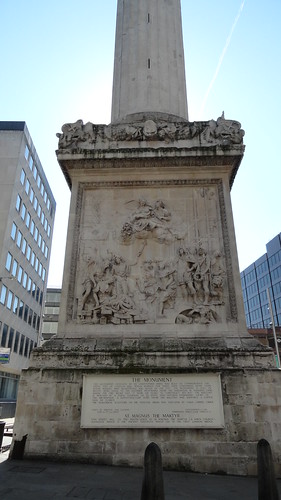 |
| Sculpture on the west face of the pedestal, by Cibber |
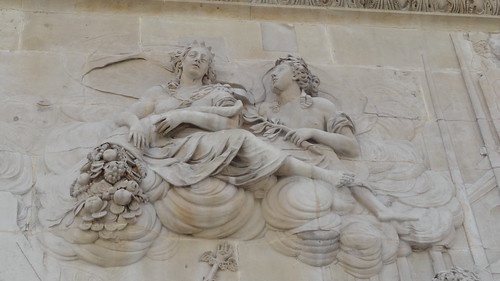 |
| Above are two goddesses, one with the cornucopia of Plenty and the other with the branch of Peace. It's hard to tell in the photo, but beneath her foot is a beehive denoting Industry. |
After that climb I was ready for a nice long sit and a cup of tea. It's been a few days and my thighs still scream when they encounter a staircase so I might wait a bit before attempting something like this again. Still, if you're one of those who likes to tick boxes on a list then a climb to the top is a must when you're seeing the sights of London. If Celia and I can do it, so can you!
Things To Know:
The Monument sits at the intersection of Monument Street and Fish Hill Street just north of London Bridge. The nearest tube stop is London Bridge. Exit the station and take the Tower Bridge Walk across the bridge. Keep going north, you'll spy it towering above you on the right.
The Monument is open daily from 9:30am to 6:00pm (last admission is 5:30pm). Prices are £3.00 for adults, £2.00 concessions (like students), and £1.50 child. There's a special combined ticket with The Tower Bridge Exhibition for £9, £6.20, and £4. Read more of its history and restoration here: http://www.themonument.info/.
After your adventure, head to Borough Market on the south end of London Bridge and treat yourself to a coffee and fresh pastry or cake. You've already worked them off!
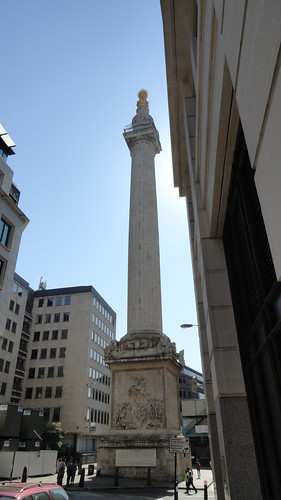
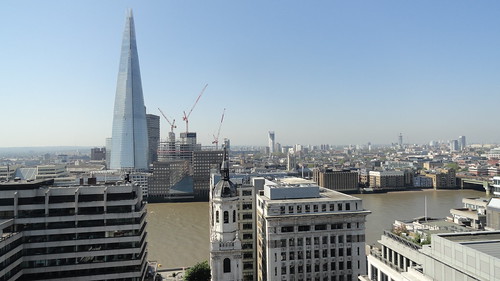
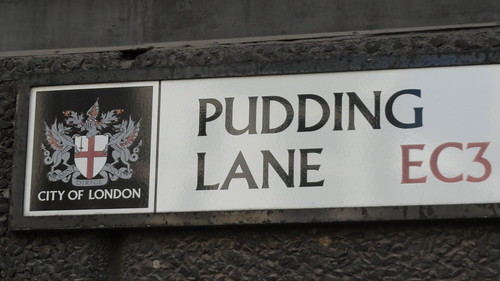
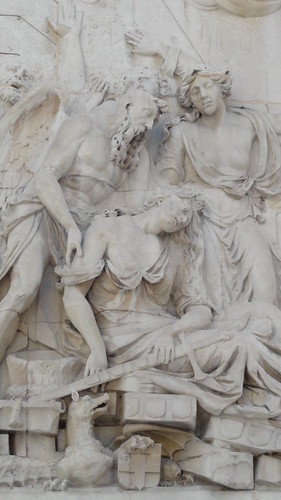
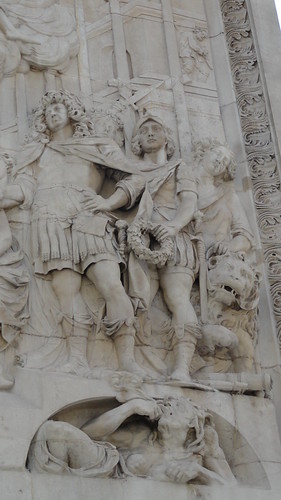
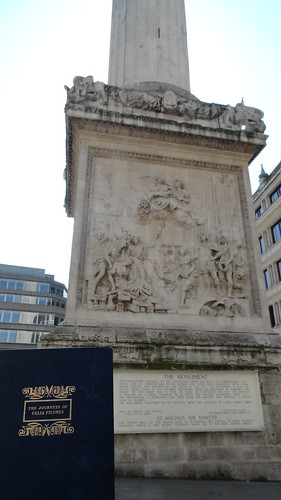





No comments:
Post a Comment